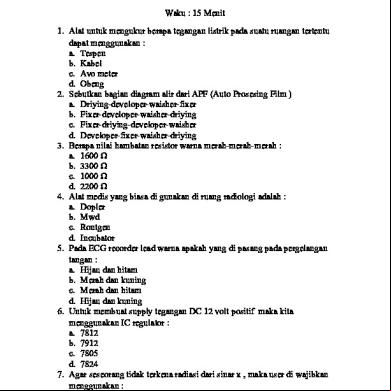Protoonkogen Onkogen 2k176u
This document was ed by and they confirmed that they have the permission to share it. If you are author or own the copyright of this book, please report to us by using this report form. Report 2z6p3t
Overview 5o1f4z
& View Protoonkogen Onkogen as PDF for free.
More details 6z3438
- Words: 827
- Pages: 22
Introduction to Oncology Prof.Dr.Sukardiman,Apt.MS Departemen Farmakognosi – Fitokimia Fakultas Farmasi UNAIR
Retroviruses Retroviruses are of one family of RNA viruses that cause cancer in variety of animals and humans. The Retrovirus is made of 3 main genes gag, pol & env that are required for virus replication but not play role in cell transformation. a retrovirus can transform cells from normal to cancer if they include a specific gene that is capable of inducing cell transformation this gene is known as “Oncogene”. Retrovirus Cancerous Retrovirus
Oncogene
Retrovirus oncogene Two main types of oncogenes:
Viral oncogene: gene from the retrovirus itself Non-Viral oncogene (Cellular oncogene): genes derived from the genes of the host cell that are in an inactive form usually. Occasionally if the gene incorporates with the viral genome will form a highly oncogenic virus.
Proto-oncogenes: are the form of cellular genes that inactive normally but can incorporate with the viral genome to produce a highly oncogenic virus.
Proto-Oncogene
Oncogene
The proto-oncogene become oncogene by: 1. Mutation: Example: mutation in Ras gene
Continuous activation of Ras by (constitutively in the GTP-bound conformation ) Unregulated cell proliferation Cell transformation.
Proto-Oncogene
Oncogene
2. Abnormal Activity: Example: Removal of the Regulatory domain in the Raf gene and replaced by gag gene Raf kinase domain consciously active Cell transformation Raf Proto-oncogene Regulatory Domain
Protein Kinase Domain
Raf oncogene gag
Protein Kinase Domain
Proto-Oncogene 3. Gene translocation: Example: c-myc gene is translocated from chromosome 8 to the IgH on the chromosome 14 resulting in abnormal c-myc expression Cell transformation
Oncogene
Proto-Oncogene
Oncogene
4. Amplification: Example: Amplification of n-myc neuroblastoma. Amplification of erbB-2 Breast & ovarian carcinomas
How does a Proto-oncogene become ?an Oncogene Proto-Oncogene
1.Mutation
2. Abnormal Activity
Oncogene
3.Gene Translocation 4. Amplification
Abnormal Activity
Functions of oncogene 1. Growth Factor (example, Epithelium growth factor EGF , and platelet derived growth factor PDGF)
2. Growth Factor Receptor (Example; PDGFR) 3. Signal transudation (example; Ras, Raf, & MEK) 4. Transcription Factor (example; Jun, Fos, Elk-1 & myc)
Oncogenes Oncogene causes cancer by affecting: 1. 2.
Cell Proliferation: (example; Ras, Raf, EGF) Cell differentiation (example, PML/RAR that inhibits the differentiation of promyelocyte to granulocyte which will maintain the cell in its active proliferate state)
3.
Cell Survival (example; Pl-3/AKT which will activate BCL-2 cell survival.
inhibit Apoptosis & maintain
PML/RAR Action Pluripotent stem cell
Myeloblast
Promyelocyte
PML/RAR
differentiation
proliferation
Tumour Suppressor Genes Tumour Suppressor genes: are genes that act to inhibit cell proliferation and tumour development. If Tumor Suppresor Gene was Mutated
OR
Inactivated
It will lead to cell transformation
Tumour Suppressor Genes Mutation of the tumour suppressor gene will cause cancer.
Example; deletion of Rb gene will cause retinoblastoma. The development of retinoblastoma can be either: Hereditary: a defective copy of Rb gene is inherited from the
affected parents. Nonhereditary: in which 2 normal Rb genes are inherited and develop mutation during life.
Retinoblastoma is developed if 2 somatic mutations inactivate both copies of Rb in the same cell.
Hereditary Mutation
Nonhereditary Mutation
Tumor Suppressor Genes Inactivation of Tumour suppressor gene will cause cancer.
If the Rb gene interact with DNA tumour virus (SV40) it will induce cell transformation. SV40
Function of Tumour Suppressor gene 1. Antagonize the action of oncogene. (ex.PTEN which converts PIPIII to PIPII because PIPIII will activate Pl-3/AKT which will activate BCL-2 that will inhibit apoptosis and induce cell transformation) PIPII
PTEN PI-3
PIPIII AKT
BCL-2
Inhibit apoptosis & induce cell transformation
Function of Tumour Suppressor gene 2. Transcription factors
Repressor transcription factors: example; WT1 is a repressor that appears to suppress transcription factor ( Insulin like growth factor) which will contribute in the development of tumour. Activator transcription factors: example; SMAD family that are activated by TGF-β, leading to inhibition of cell proliferation.
Function of Tumour Suppressor gene 3. Regulate cell cycle :
Rb gene: that inhibits the cell cycle in the G1 phase decrease cell proliferation. INK-4 gene: that produces P16 that inhibits cdk4/cyclin D action ( to phosphorylate Rb gene to inactivate it’s action) P53: that produces P21 that has the same action of P16 in inhibiting the action of cdk4/cyclin D
Regulate cell cycle P16
P
Cdk4/cyclin D
Rb
Rb Rb inactive
S
G1
M
G2
Cell Cycle Blocked
G1 S M
G2
Cell Cycle Proceeds
Function of Tumour Suppressor gene 4. Induce apoptosis:
P53 release will increase Bax holes in the mitochondria release cytochrom c activate apoptosis
form
Cancer Detection Cancer detection :
Clinical detection by mammogram, coloscopy… etc Molecular detection by Cerotype Restriction fragment length polymorphism (RFLP) PCR Western Blot
Cancer Treatment Chemotherapy:
Deals with DNA damage, & has affinity to all proliferating cells not specifying if it was a cancer cell or not.
Inhibiting Angiogenesis
Inhibit blood flow/supply to the tumour cells
Decrease franesylation of Ras
Decrease activation of Ras, because Ras mutation causes most cancers.
Monoclonal Antibody
Retroviruses Retroviruses are of one family of RNA viruses that cause cancer in variety of animals and humans. The Retrovirus is made of 3 main genes gag, pol & env that are required for virus replication but not play role in cell transformation. a retrovirus can transform cells from normal to cancer if they include a specific gene that is capable of inducing cell transformation this gene is known as “Oncogene”. Retrovirus Cancerous Retrovirus
Oncogene
Retrovirus oncogene Two main types of oncogenes:
Viral oncogene: gene from the retrovirus itself Non-Viral oncogene (Cellular oncogene): genes derived from the genes of the host cell that are in an inactive form usually. Occasionally if the gene incorporates with the viral genome will form a highly oncogenic virus.
Proto-oncogenes: are the form of cellular genes that inactive normally but can incorporate with the viral genome to produce a highly oncogenic virus.
Proto-Oncogene
Oncogene
The proto-oncogene become oncogene by: 1. Mutation: Example: mutation in Ras gene
Continuous activation of Ras by (constitutively in the GTP-bound conformation ) Unregulated cell proliferation Cell transformation.
Proto-Oncogene
Oncogene
2. Abnormal Activity: Example: Removal of the Regulatory domain in the Raf gene and replaced by gag gene Raf kinase domain consciously active Cell transformation Raf Proto-oncogene Regulatory Domain
Protein Kinase Domain
Raf oncogene gag
Protein Kinase Domain
Proto-Oncogene 3. Gene translocation: Example: c-myc gene is translocated from chromosome 8 to the IgH on the chromosome 14 resulting in abnormal c-myc expression Cell transformation
Oncogene
Proto-Oncogene
Oncogene
4. Amplification: Example: Amplification of n-myc neuroblastoma. Amplification of erbB-2 Breast & ovarian carcinomas
How does a Proto-oncogene become ?an Oncogene Proto-Oncogene
1.Mutation
2. Abnormal Activity
Oncogene
3.Gene Translocation 4. Amplification
Abnormal Activity
Functions of oncogene 1. Growth Factor (example, Epithelium growth factor EGF , and platelet derived growth factor PDGF)
2. Growth Factor Receptor (Example; PDGFR) 3. Signal transudation (example; Ras, Raf, & MEK) 4. Transcription Factor (example; Jun, Fos, Elk-1 & myc)
Oncogenes Oncogene causes cancer by affecting: 1. 2.
Cell Proliferation: (example; Ras, Raf, EGF) Cell differentiation (example, PML/RAR that inhibits the differentiation of promyelocyte to granulocyte which will maintain the cell in its active proliferate state)
3.
Cell Survival (example; Pl-3/AKT which will activate BCL-2 cell survival.
inhibit Apoptosis & maintain
PML/RAR Action Pluripotent stem cell
Myeloblast
Promyelocyte
PML/RAR
differentiation
proliferation
Tumour Suppressor Genes Tumour Suppressor genes: are genes that act to inhibit cell proliferation and tumour development. If Tumor Suppresor Gene was Mutated
OR
Inactivated
It will lead to cell transformation
Tumour Suppressor Genes Mutation of the tumour suppressor gene will cause cancer.
Example; deletion of Rb gene will cause retinoblastoma. The development of retinoblastoma can be either: Hereditary: a defective copy of Rb gene is inherited from the
affected parents. Nonhereditary: in which 2 normal Rb genes are inherited and develop mutation during life.
Retinoblastoma is developed if 2 somatic mutations inactivate both copies of Rb in the same cell.
Hereditary Mutation
Nonhereditary Mutation
Tumor Suppressor Genes Inactivation of Tumour suppressor gene will cause cancer.
If the Rb gene interact with DNA tumour virus (SV40) it will induce cell transformation. SV40
Function of Tumour Suppressor gene 1. Antagonize the action of oncogene. (ex.PTEN which converts PIPIII to PIPII because PIPIII will activate Pl-3/AKT which will activate BCL-2 that will inhibit apoptosis and induce cell transformation) PIPII
PTEN PI-3
PIPIII AKT
BCL-2
Inhibit apoptosis & induce cell transformation
Function of Tumour Suppressor gene 2. Transcription factors
Repressor transcription factors: example; WT1 is a repressor that appears to suppress transcription factor ( Insulin like growth factor) which will contribute in the development of tumour. Activator transcription factors: example; SMAD family that are activated by TGF-β, leading to inhibition of cell proliferation.
Function of Tumour Suppressor gene 3. Regulate cell cycle :
Rb gene: that inhibits the cell cycle in the G1 phase decrease cell proliferation. INK-4 gene: that produces P16 that inhibits cdk4/cyclin D action ( to phosphorylate Rb gene to inactivate it’s action) P53: that produces P21 that has the same action of P16 in inhibiting the action of cdk4/cyclin D
Regulate cell cycle P16
P
Cdk4/cyclin D
Rb
Rb Rb inactive
S
G1
M
G2
Cell Cycle Blocked
G1 S M
G2
Cell Cycle Proceeds
Function of Tumour Suppressor gene 4. Induce apoptosis:
P53 release will increase Bax holes in the mitochondria release cytochrom c activate apoptosis
form
Cancer Detection Cancer detection :
Clinical detection by mammogram, coloscopy… etc Molecular detection by Cerotype Restriction fragment length polymorphism (RFLP) PCR Western Blot
Cancer Treatment Chemotherapy:
Deals with DNA damage, & has affinity to all proliferating cells not specifying if it was a cancer cell or not.
Inhibiting Angiogenesis
Inhibit blood flow/supply to the tumour cells
Decrease franesylation of Ras
Decrease activation of Ras, because Ras mutation causes most cancers.
Monoclonal Antibody






